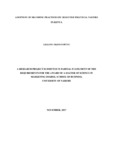| dc.description.abstract | Branding is growing globally as a priority for every provider of a service, product or an idea.
Political branding which is a core facet of Political Marketing has become part of the political
culture for most democracies. Kenya for instance held a general election in August 2017,
following an intense electioneering period characterized by a variety of marketing activities,
political party realignments and campaigns. Evident during this season were major political
rallies, colourful road shows and attires, social media campaigns and advertisements to
promote the different parties and their candidates. The marketing strategies of the political
parties in Kenya, especially as related to branding had not been studied before. This study,
therefore, sought to explore the branding practices adopted by political parties in Kenya as a
contribution to the growing literature on political branding which is a new frontier in political
marketing. The objective of the study was to determine how the branding practices manifest
in selected political parties. A descriptive research design was deployed, with a sample of 9
the bigger political parties. Primary data was drawn from questionnaires administered to
party officials and interviews with key stakeholders. Party web sites, advertisements and
social media pages provided sources of secondary data. Thematic analysis of the qualitative
data enabled the identification, analysis and reporting of patterns within the data generated in
the study around application of branding concepts, strategies and frameworks. The study
established that the political parties had implemented key aspects such as brand elements,
positioning and communication to a great extent. It was further established that although
political party executives generally understood the concept of branding, the focus was on
implementing selected aspects, citing resource constraints, knowledge and information gaps.
The findings also indicated that most branding was done during electioneering and campaign
period and not as a continuous, long term strategy. The study concludes that a successful
party brand must develop strategies for the brand management while building a united brand
image on voter issues, party policies, party leaders, candidates and other services based on
the core values of the party. All these must be correctly positioned and communicated in a
consistent message to the electorate to meet the different target needs. Recommendations for
future studies include studies to measure the individual parties brand equity from the
customer perspective; this would be useful to build, leverage and sustain brand equity for
electoral success. Additionally on the party branding, further research on separate
components of the branding practices would reveal the performance and adoption level of
individual political parties with an in-depth understanding to address challenges and
strategies for efficient delivery of the parties brand promise which is the key premise of
branding. | en_US |



